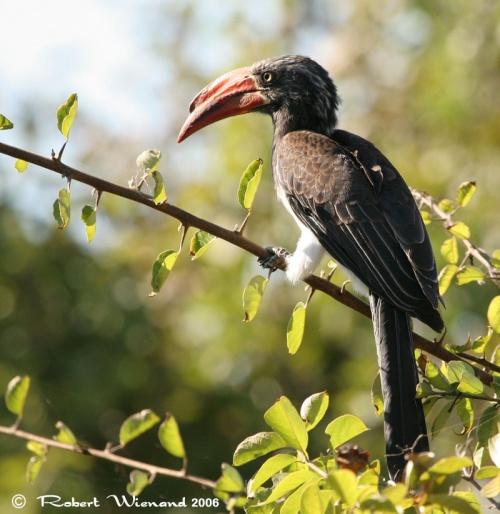(Picture of female. Distribution, Taxonomy & Habitat expanded. . References) |
|||
| Line 1: | Line 1: | ||
| − | [[Image:Crowned_Hornbill.jpg|thumb| | + | [[Image:Crowned_Hornbill.jpg|thumb|500px|right|Photo by safariranger <br />[[South Luangwa National Park]], [[Zambia]]]] |
;[[:Category:Tockus|Tockus]] alboterminatus | ;[[:Category:Tockus|Tockus]] alboterminatus | ||
==Identification== | ==Identification== | ||
| Line 11: | Line 11: | ||
*Casque on the upper mandible (females have smaller casque) | *Casque on the upper mandible (females have smaller casque) | ||
==Distribution== | ==Distribution== | ||
| − | Sub-Saharan [[Africa]] east of 10°E. | + | Sub-Saharan [[Africa]] east of 10°E.<br /> |
| + | [[Image:12368Crowned Hornbill F2.jpg|thumb|350px|right|Female<br />Photo by {{user|rudydbn|rudydbn}}<br />Pennington, [[KwaZulu-Natal]], August 2004]] | ||
| + | '''Western Africa''': [[Equatorial Guinea]], [[Democratic Republic of Congo]] and [[Angola]]<br /> | ||
| + | '''Eastern Africa''': [[Sudan]], [[Ethiopia]], [[Somalia]], [[Kenya]], [[Uganda]], [[Rwanda]], [[Burundi]], [[Tanzania]], [[Zanzibar]], [[Zambia]], [[Mozambique]] and [[Malawi]]<br /> | ||
| + | '''Southern Africa''': [[Namibia]], [[Zimbabwe]], [[South Africa]], [[KwaZulu-Natal]] and [[Swaziland]] | ||
==Taxonomy== | ==Taxonomy== | ||
| − | + | This is a [[Dictionary_M-S#M|monotypic]] species<sup>[[#References|[1]]]</sup>. | |
| − | + | ||
| − | + | Three subspecies ''alboterminatus'', ''geloensis'' and ''suahelicus'' are not generally recognised<sup>[[#References|[2]]]</sup>. | |
| − | |||
==Habitat== | ==Habitat== | ||
| − | + | Inland, coastal, highland and riverine evergreen forests; coastal dunes and mixed grassland forest areas. | |
==Behaviour== | ==Behaviour== | ||
| + | ====Diet==== | ||
The diet includes aerially hawked insects, small rodents, frogs, seeds and fruits. | The diet includes aerially hawked insects, small rodents, frogs, seeds and fruits. | ||
| − | + | ====Breeding==== | |
| − | 4-5 white eggs | + | The 4-5 white eggs are incubated for 25-30 days; the young fledge about 8 weeks later. |
| − | |||
==References== | ==References== | ||
| − | Wikipedia | + | #{{Ref-Clements6thAug11}}#Avibase |
| + | #BF Member observations | ||
| + | #Wikipedia | ||
| + | {{ref}} | ||
==External Links== | ==External Links== | ||
{{GSearch|Tockus+alboterminatus}} | {{GSearch|Tockus+alboterminatus}} | ||
[[Category:Birds]] [[Category:Tockus]] | [[Category:Birds]] [[Category:Tockus]] | ||
Revision as of 22:45, 2 November 2011
- Tockus alboterminatus
Identification
50-54 cm.
- Black back
- Black wings
- White belly
- White tipped, long tail feathers
- Yellow iris
- Red bill
- Casque on the upper mandible (females have smaller casque)
Distribution
Sub-Saharan Africa east of 10°E.
Western Africa: Equatorial Guinea, Democratic Republic of Congo and Angola
Eastern Africa: Sudan, Ethiopia, Somalia, Kenya, Uganda, Rwanda, Burundi, Tanzania, Zanzibar, Zambia, Mozambique and Malawi
Southern Africa: Namibia, Zimbabwe, South Africa, KwaZulu-Natal and Swaziland
Taxonomy
This is a monotypic species[1].
Three subspecies alboterminatus, geloensis and suahelicus are not generally recognised[2].
Habitat
Inland, coastal, highland and riverine evergreen forests; coastal dunes and mixed grassland forest areas.
Behaviour
Diet
The diet includes aerially hawked insects, small rodents, frogs, seeds and fruits.
Breeding
The 4-5 white eggs are incubated for 25-30 days; the young fledge about 8 weeks later.
References
- Clements, JF. 2011. The Clements Checklist of Birds of the World. 6th ed., with updates to August 2011. Ithaca: Cornell Univ. Press. ISBN 978-0801445019. Spreadsheet available at http://www.birds.cornell.edu/clementschecklist/downloadable-clements-checklist
- Avibase
- BF Member observations
- Wikipedia
Recommended Citation
- BirdForum Opus contributors. (2024) Crowned Hornbill. In: BirdForum, the forum for wild birds and birding. Retrieved 24 April 2024 from https://www.birdforum.net/opus/Crowned_Hornbill





